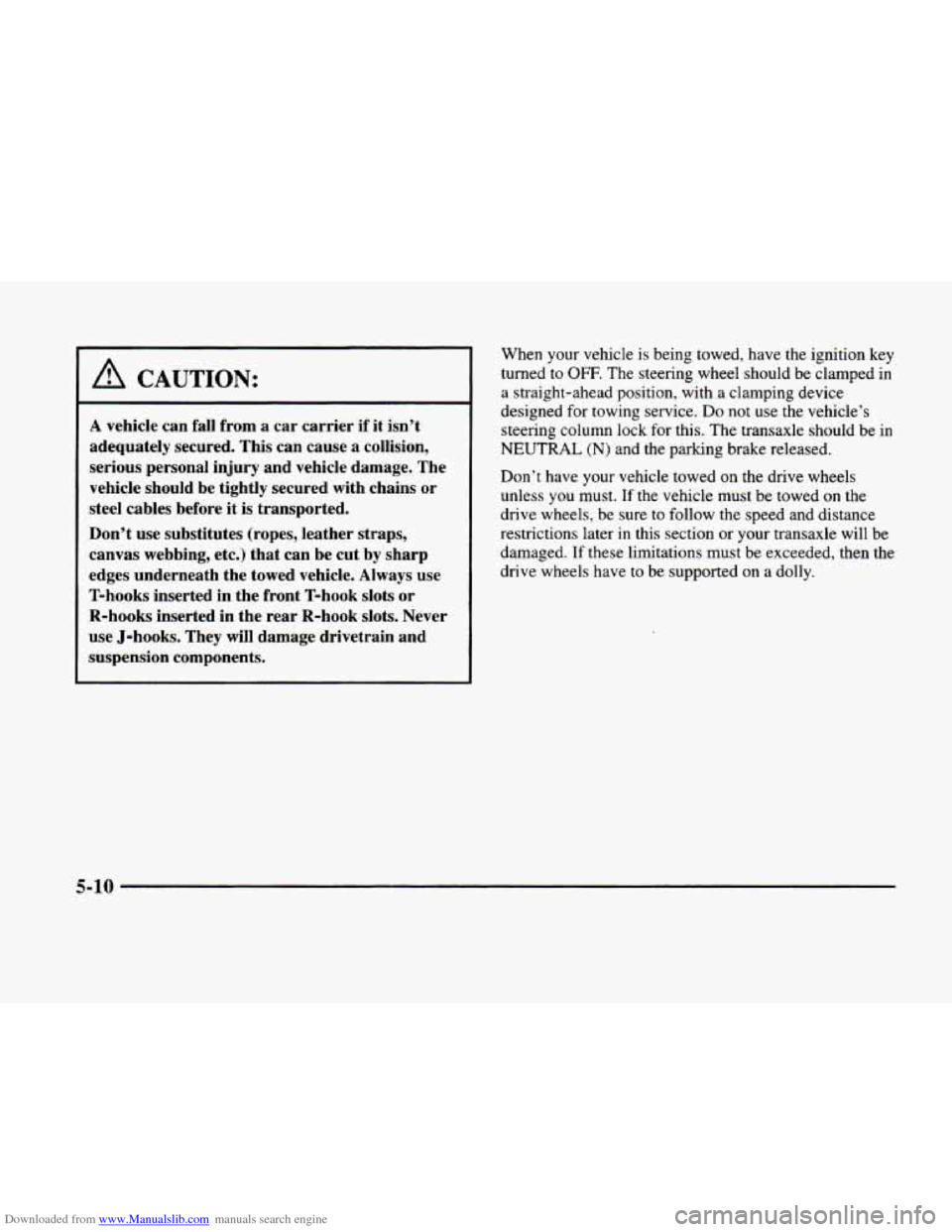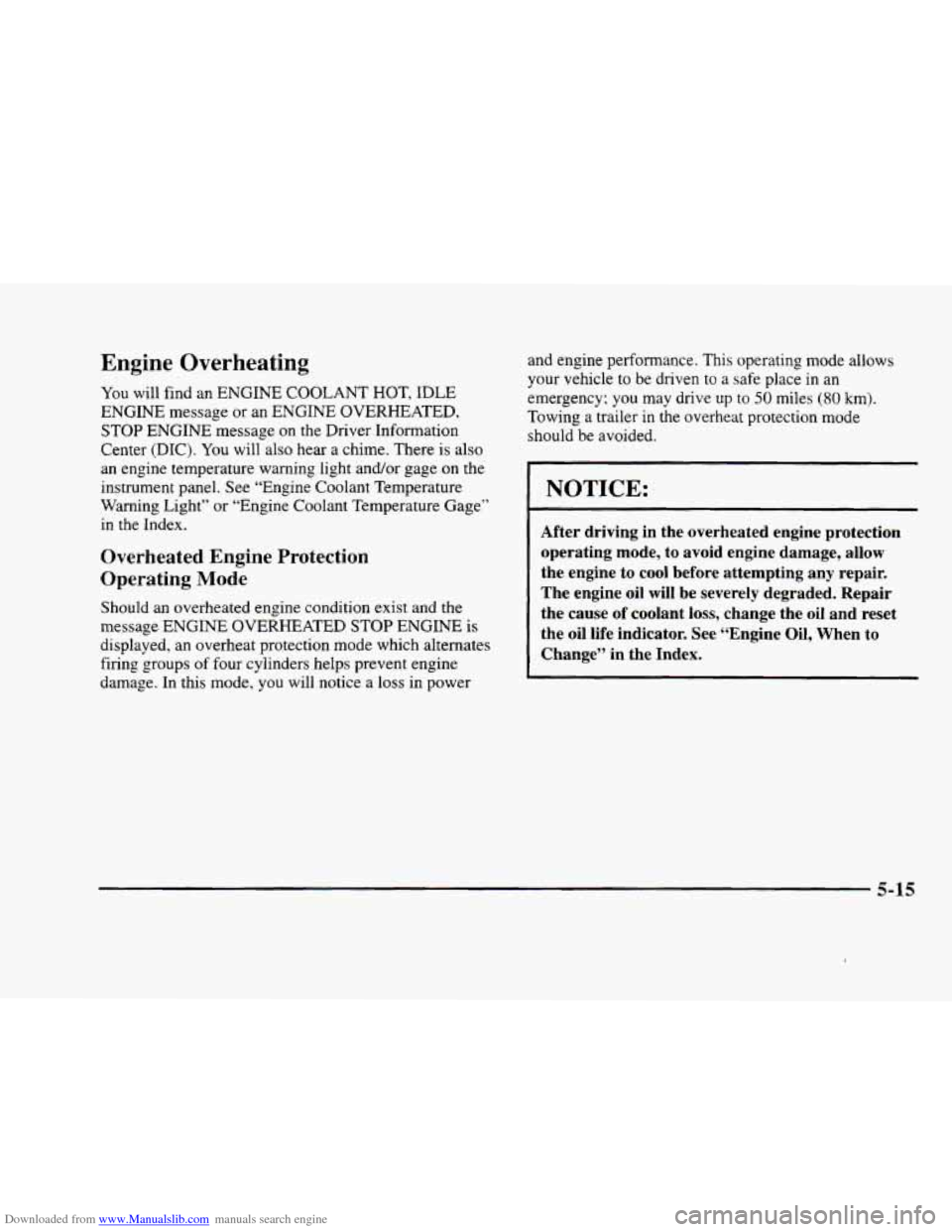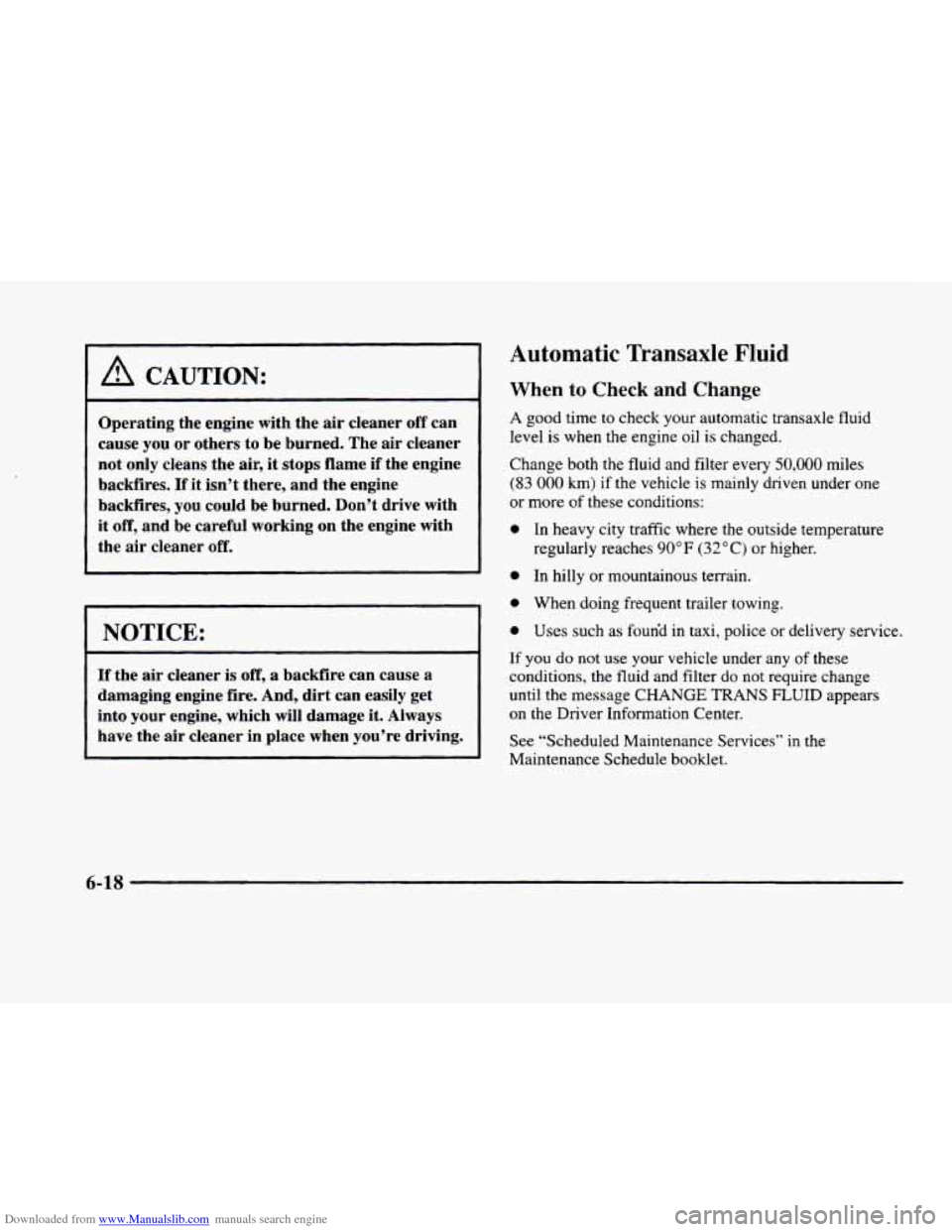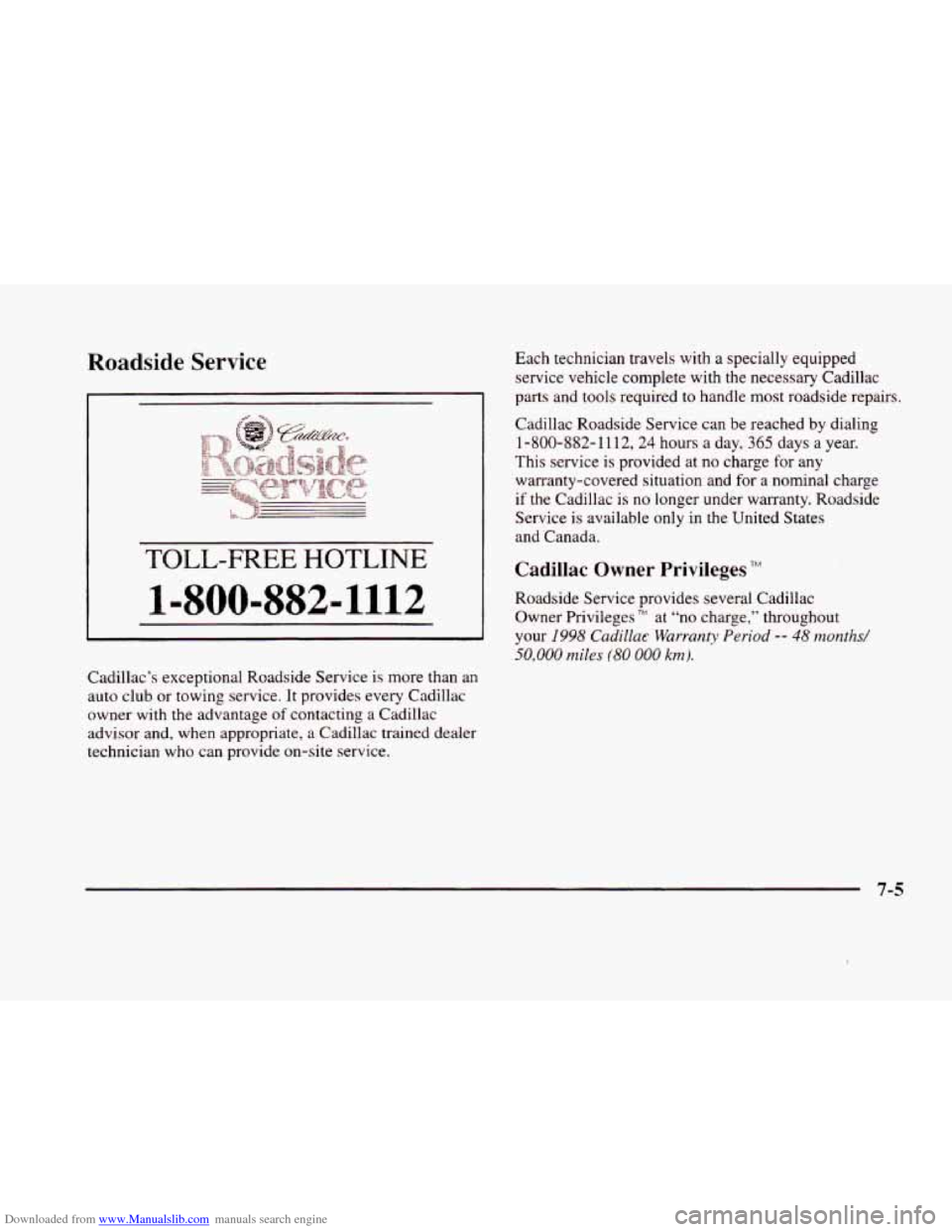Page 249 of 380
Downloaded from www.Manualslib.com manuals search engine Front Towing
Rear Towing
A CAUTION:
To help avoid injury to you or others:
0
0
0
0
Never let passengers ride in a vehicle that is
being towed.
Never tow faster than safe or posted speeds.
Never tow with damaged parts not
fully secured. Never get under your vehicle after it has
been lifted by the tow truck.
Always secure the vehicle on each side with
separate safety chains when towing it.
Never use J-hooks. Use only T-hooks in the
front T-hook
slots and only R-hooks in the
rear R-hook
slots.
5-9
Page 250 of 380

Downloaded from www.Manualslib.com manuals search engine A vehicle can fall from a car carrier if it isn’t
adequately secured. This can cause a collision,
serious personal injury and vehicle damage. The
vehicle should be tightly secured
with chains or
steel cables before it is transported.
Don’t use substitutes (ropes, leather straps,
canvas webbing, etc.) that can be cut by sharp
edges underneath the towed vehicle. Always use
T-hooks inserted in the front T-hook
slots or
R-hooks inserted in the rear R-hook
slots. Never
use J-hooks. They
will damage drivetrain and
suspension components.
When your vehicle is being towed, have the ignition key
turned to
OFF. The steering wheel should be clamped in
a straight-ahead position, with a clamping device
designed for towing service.
Do not use the vehicle’s
steering column lock for this. The transaxle should be
in
NEUTRAL (N) and the parking brake released.
Don’t have your vehicle towed on the drive wheels
unless
you must. If the vehicle must be towed on the
drive wheels, be sure to follow the speed and distance
restrictions later in this section
or your transaxle will be
damaged. If these limitations must be exceeded, then the
drive wheels have to be supported on
a dolly.
5-10
Page 251 of 380
Downloaded from www.Manualslib.com manuals search engine Front Towing
Tow Limits -- 35 mph (55 kplz), 25 miles (40 km)
L‘
NOTICE:
Do not tow with sling type equipment or
fascidfog lamp damage
will occur. Use wheel-lift
or car-carrier equipment. Additional ramping
may be required for car-carrier equipment. Use
safety chains and wheel straps.
Towing a vehicle over rough surfaces could
damage a vehicle. Damage can occur from
vehicle to ground or vehicle to wheel-lift
equipment. To help avoid damage, install
a
towing dolly and raise the vehicle until adequate
clearance is obtained between the ground andor
wheel-lift equipment.
Do not attach winch cables or J-hooks to
suspension components when using car-carrier
equipment. Always use T-hooks inserted in the
T-hook slots.
5-11
Page 253 of 380
Downloaded from www.Manualslib.com manuals search engine r L
r
f
Rear Towing
Tow Limits -- 35 mph (55 kph), 25 miles (40 km)
r
r
r
r
I
NOTICE:
Do not tow with sling type equipment or rear
bumper valance damage will occur. Use wheel-lift
or car-carrier equipment. Additional ramping
may be required for car-carrier equipment. Use
safety chains and wheel straps.
Towing a vehicle over rough surfaces could
damage
a vehicle. Damage can occur from
vehicle to ground or vehicle to wheel-lift
equipment.
To help avoid damage, install a
towing dolly and raise the vehicle until adequate
clearance is obtained between the ground and/or
wheel-lift equipment.
Do not attach winch cables or J-hooks to
suspension components when using carcarrier
equipment. Always use R-hooks inserted in
the R-hook slots.
5-13
Page 255 of 380

Downloaded from www.Manualslib.com manuals search engine Engine Overheating
You will find an ENGINE COOLANT HOT, IDLE
ENGINE message or an ENGINE OVERHEATED,
STOP ENGINE message
on the Driver Information
Center (DIC).
You will also hear a chime. There is also
an engine temperature warning light and/or gage
on the
instrument panel. See “Engine Coolant Temperature
Warning Light” or “Engine Coolant Temperature Gage”
in the Index.
Overheated Engine Protection
Operating
Mode
Should an overheated engine condition exist and the
message ENGINE OVERHEATED
STOP ENGINE is
displayed, an overheat protection mode which alternates
firing groups
of four cylinders helps prevent engine
damage. In this mode, you will notice a loss in power and
engine performance. This operating mode allows
your vehicle to be driven to a safe place
in an
emergency; you may drive
up to 50 miles (80 km).
Towing a trailer in the overheat protection mode
should be avoided.
-~
NOTICE:
After driving in the overheated engine protection
operating mode, to avoid engine damage, allow
the engine to cool before attempting any repair.
The engine oil will be severely degraded. Repair
the cause of coolant loss, change the oil and reset
the oil life indicator. See “Engine Oil, When to
Change”
in the Index.
5-15
Page 276 of 380
Downloaded from www.Manualslib.com manuals search engine NOTICE:
Spinning your wheels can destroy parts of your
vehicle as well as the tires. If you spin the wheels
too fast while shifting your transaxle back and
forth, you can destroy your transaxle.
For information about using tire chains on your vehicle,
see “Tire Chains” in the Index.
Rocking Your Vehicle To Get It Out
First, turn your steering wheel left and right. That will
clear the area around your front wheels. You should
turn your traction control system off. (See “Traction
Control System”
in the Index.) Then shift back and forth
between REVERSE
(R) and a forward gear, spinning the
wheels as little
as possible. Release the accelerator pedal
while you shift, and press lightly
on the accelerator
pedal
when the transaxle is in gear. If that doesn’t get
you out after a few tries, you may need to be towed out.
If you do need
to be towed out, see “Towing Your
Vehicle” in the Index.
5-36
Page 298 of 380

Downloaded from www.Manualslib.com manuals search engine A CAUTION:
Operating the engine with the air cleaner off can
cause you or others to be burned. The air cleaner
not only cleans the air, it stops flame
if the engine
backfires.
If it isn’t there, and the engine
backfires,
you could be burned. Don’t drive with
it
off, and be careful working on the engine with
the air cleaner off.
NOTICE:
If the air cleaner is off, a backfire can cause a
damaging engine fire. And, dirt can easily get
into your engine, which will damage it. Always
have the air cleaner in place when you’re driving.
Automatic Transaxle Fluid
When to Check and Change
A good time to check your automatic transaxle fluid
level is when the engine oil is changed.
Change both the fluid and filter every
50,000 miles
(83 000 km) if the vehicle is mainly driven under one
or more
of these conditions:
0 In heavy city traffic where the outside temperature
0 In hilly or mountainous terrain.
0 When doing frequent trailer towing.
0 Uses such as found in taxi, police or delivery service.
If you do not use your vehicle under any
of these
conditions, the fluid and filter do not require change
until the message
CHANGE TRANS FLUID appears
on the Driver Information Center.
See “Scheduled Maintenance Services” in the
Maintenance Schedule booklet.
regularly
reaches
90” F (32 O C j or higher.
6-18
Page 351 of 380

Downloaded from www.Manualslib.com manuals search engine Roadside Service
TOLL-FREE HOTLINE
l=SOO-882-1112
Cadillac’s exceptional Roadside Service is more than an
auto club or towing service.
It provides every Cadillac
owner with the advantage
of contacting a Cadillac
advisor and. when appropriate, a Cadillac trained dealer
technician who can provide on-site service. Each technician
travels with
a specially equipped
service vehicle complete with the necessary Cadillac
parts and tools required
to handle most roadside repairs.
Cadillac Roadside Service can be reached by dialing
1-800-882-1 112,24 hours a day,
365 days a year.
This service is provided at no charge for any
warranty-covered situation and for a nominal charge
if
the Cadillac is no longer under warranty. Roadside
Service
is available only in the United States
and Canada.
Cadillac Owner Privileges TM
Roadside Service provides several Cadillac
Owner Privileges
TM at “no charge,” throughout
your
1998 Cadillac Warranty Period -- 48 months/
50,000 miles (80 000 km).
7-5